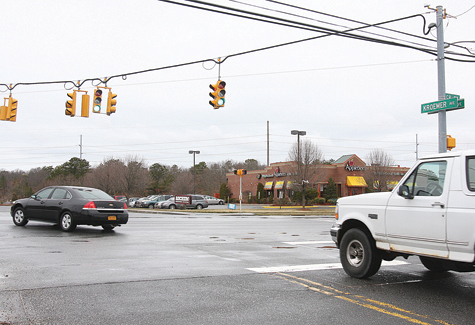Why Riverhead ambulances are no longer seeing red
After years of weaving through traffic lights on Route 58 on their way to emergencies, Riverhead ambulance volunteers are no longer seeing red.
For the past year, along Riverhead Town’s busiest road, a new system that changes red lights to green as ambulances approach has helped first responders get to alarms faster.
The Opticom system used by the Riverhead Volunteer Ambulance Corps employs GPS and radio signals to communicate between ambulances and antennas attached to traffic lights along Route 58, said ambulance chief Joseph Oliver.
As an ambulance approaches a traffic light, the system triggers any red lights along the ambulance’s route to switch to green, Mr. Oliver said. The GPS also registers how fast the ambulance is traveling and whether it’s turning, he said.
The new system has cut down on the ambulance corps’ response times since it was installed in early 2012 and has made it safer for ambulances to respond to calls.
“If we get in an accident, it doesn’t matter how serious the emergency, we’re not going,” Mr. Oliver said.
The antennas are attached to the traffic signals from Tanger Outlets to Ostrander Avenue, he said. Any new lights built on the road will have the system.
The Opticom system is designed to give cars in the opposite lanes a yellow then red light, with enough time for them to stop and let the ambulance through, he said. The corps now has Opticom installed in all its ambulances and fi rst responder vehicles. It paid for two of the transmitters — which cost roughly $2,000 a piece — but the other seven were donated.
Brookhaven Town fire departments and ambulance crews are switching over to the system thanks to grant funding, Mr. Oliver said.
Riverhead Town Police Chief David Hegermiller said the department could benefit from a light-preemption system. Funding has been the biggest hurdle, as the police department would need far more transmitters than the ambulance corps.
“It would be great to have, but currently it is unfunded,” Chief Hegermiller said.
The system doesn’t mean ambulance drivers can be careless, though. The drivers still slow down as they approach a light in case any other cars are running the red light in the other direction, Mr. Oliver said, a problem that occurs far too often to his liking.
He said volunteers see drivers running the red lights “every day, just because people aren’t paying attention. Always pay attention because it could change really quickly.”








